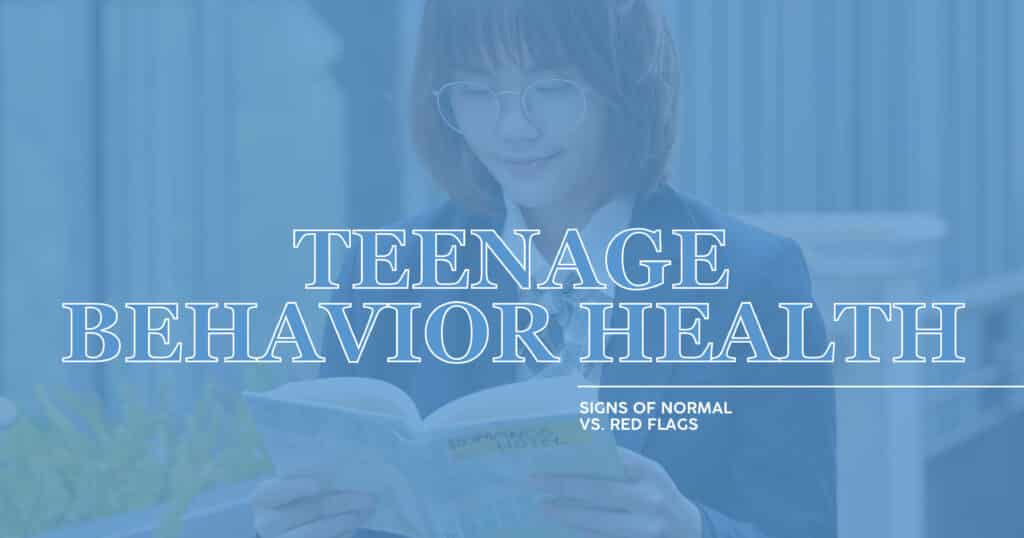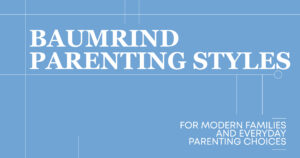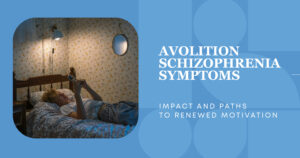Being a parent to a teenager is a totally different kind of experience. It has its rewards and its challenges. For the most part, we can define adolescence as the stage of growth and change where the development of behaviors stirs emotions that define parent’s lives. It is essential to understand adolescent behavior health in order for parents to be enlightened about when normal behavior becomes an age definition or a real concern.
This guide discusses normal teenage behavior health versus teenage behavioral red flags, helping parents and guardians detect warning signs in teenagers’ behavior and take appropriate action.
What Are Red Flag Behaviors?
Dramatic changes and enormous growth characterize significant transition periods into adulthood, often accompanied by intense mood fluctuations, impulsivity, and desires for independence. Teenagers display these characteristic behavioral examples as they learn the challenging act of growing up.
Although some adolescent behaviors are commonly explained in the general scheme of developmental changes, they can go beyond the norm and become very serious patterns that require close attention. Such awareness and early intervention make an enormous difference to any teen’s mental and psychological well-being.
Understanding Normal Teenage Behavior
Teens typically display behavior associated with various milestones in identity development regarding their need to become independent of the family, establish a personal identity, and learn about social relations. These behaviors include:
Testing Boundaries
Such behavior is typical of teenagers, who usually attempt to defy rules or the authority imposed on them by their parents to show that they are slightly different individuals and becoming autonomous.
Shifting Social Preferences
Changing between friends is said to be an adolescent’s most common act as they explore several combinations of how they can associate with others and what variations among friends contribute.
Emotional Variability
Changes in hormones can also lead to mood swings or tantrums, but in a few minutes, it can help see the opposite.
Seeking Privacy
As teens develop their sense of self, they naturally desire personal space and time alone. They require private space and time to build their understanding of individualism and identity.
Most of these actions are harmless and part of the natural growth process, although they are quite difficult for parents to handle in general. By identifying these behaviors as usual, unnecessary worries can be avoided.
What Defines Red Flag Behaviors?
Teens displaying normal behavior or, more accurately, abnormal behavior will also include red flags at some point in either long-term alterations or extremes that usually adversely affect functioning day in and day out. Such conduits will give rise to latent danger for a teen with psychological issues or covert behavior issues that should be considered in adolescents and require intervention.
Key characteristics of red flag behaviors include:
- Persistent Patterns. Mood swings or typical rebelliousness are not signs that the behavior will persist for weeks or months without improving. This could mean that the difficulty won’t fix itself.
- Disruption to Daily Life. These behaviors indicate something much more profound. For example, skipping, failing grades, or avoiding the people who should love them can be signs of serious teen behavior problems and indicators that something deeper is happening.
- Harmful Actions. Self-harm, aggression, or impulsive behaviors are considered hazardous indicators that must not be overlooked.
Examples of Red Flag Behaviors
To further differentiate normal teenage behavior health from troubling patterns, here are specific examples of teenage behavioral red flags that parents and caregivers should watch for:
- Chronic Defiance. Occasional rule-breaking is normal, but ongoing defiance against authority and aggression usually points to deeper emotional or behavioral issues.
- Extreme Isolation. The other initiatives will include not seeing friends or family or pursuing any activity they enjoy and will be associated with either anxiety or depression or many different mental illnesses.
- Risky Behaviors. Repeatedly doing something such as “using substances,” “driving recklessly,” or “engaging in random dangerous stunts” indicates no concern for one’s safety.
- Unexplained Physical Changes. Unexplained Changes in the Body Sometimes, weight fluctuations, poor hygiene, or self-harm accompany major developments in physical characteristics. These changes are often associated with serious issues related to mental or general health.
- Overwhelming Emotional Responses. The result is that prolonged spells of dejection, emotional explosions, panic attacks, or irritability may seem somewhat disproportionate to the situation because it manifests apparent psychological problems.
Why It’s Crucial to Differentiate
You can miss an opportunity for early intervention when you fail to distinguish normal teenage behavior health from warning signs in adolescent behavior. For instance:
- Behaviors like mood swings or boundary testing are often issues that self-resolve as the teen matures.
- Red flag behaviors, however, might eventually lead to much worse problems such as substance abuse, academic failure, or chronic long-term mental health issues if left untreated.
Parents and caregivers can promote a supportive environment while ensuring that teens receive the help they need when their behavior is outside typical development.
Common Red Flags in Teenage Behavior
Identifying teenage behavioral red flags begins with understanding those behaviors exceed the usual adolescent hood. Some of the most serious, worrisome teen behaviors include:
-
Sudden and Persistent Isolation
Not all teenagers enjoy time alone. So a compulsive staying away from family and friends may indicate depression, anxiety, or other mental health warning signs.
-
Uncharacteristic Risk-Taking
All of these risky behaviors, drug experimentation with a bit of alcohol, perhaps some stunts to prove it’s within the realm of survival, etc, can give you the indicators of teen behavioral problems.
-
Frequent and Intense Mood Swings
Mood swings typically are everyday phenomena associated with adolescents, but they can also indicate a severe underlying mood disorder when they escalate to extremes.
-
Drastic Physical Changes
Weight changes that are sudden and inexplicable, along with neglect of self, can be signs of mental problems or the presence of an eating disorder.
-
Secretive or Deceptive Behaviors
Teenagers becoming overly secretive about their activities, devices, or whereabouts are likely engaged in trouble-causing behaviors.
How Do Teenagers Act? Normal Vs. Troubling Behaviors
Typical Teenage Actions
- Those things would be odd or, sometimes, just a tad rebellious.
- Experimenting with fashions, hairstyles, or with various types of clothes.
- Spending most of one’s time with friends rather than with family members.
Troubling Teen Behaviors
- Chronic defiance or hostility toward authority figures.
- Compulsive ruminating with harmful thoughts.
- Inability to follow responsibilities such as hygienic habits or school homework.
How to Spot Red Flag Behaviors in Teens
Spotting teen mental health warning signs involves knowing what to look for and how to interpret changes in your teen’s actions or personality.
Keep Lines of Communication Open
Consistent and open communication forms the foundation of a healthy parent-child relationship.
- Encourage Non-judgmental Conversations. Let your teen express themselves without fear of criticism.
- Practice Active Listening. Show empathy and validate their emotions, even if you disagree.
- Regular Check-ins. Create routines for discussing their day, feelings, and any challenges.
Watch for Secrecy
While privacy is a natural part of growing up, excessive secrecy may point to adolescent behavioral issues.
- Monitor changes in how they use technology (e.g., deleting messages or switching apps).
- Look for signs of lying about their activities or whereabouts.
- Address secrecy calmly, emphasizing concern and trust rather than punishment.
Note Changes in Baseline Behaviors
Baseline behaviors are your teen’s usual patterns in sleep, mood, socialization, and habits. Abrupt or prolonged shifts in these areas may signal teenage behavioral red flags:
- Sudden disinterest in hobbies or passions.
- Significant changes in eating or sleeping patterns.
- Increasing conflict with family or friends.
Why Do Red Flag Behaviors Happen?
Biological and Hormonal Changes
Adolescents experience significant hormonal fluctuations that can affect mood and behavior.
Environmental and Social Stressors
- Academic pressures or struggles.
- Bullying or peer pressure.
- Family conflicts or trauma.
Mental Health Conditions
Conditions such as anxiety, depression, or ADHD can lead to troubling teen behaviors if left untreated.
What to Do If You Notice Red Flags
When you observe teenage behavioral red flags, taking prompt and thoughtful action is essential to support your teen and address any underlying issues. Ignoring these warning signs in adolescent behavior can lead to long-term consequences, so early intervention is key. Here’s a step-by-step guide to help you navigate these challenges effectively:
Seek Professional Help
- Reach Out to Specialists. Schedule an appointment with a pediatrician, school counselor, therapist, or psychologist specializing in adolescent behavioral issues. These professionals can conduct thorough evaluations to identify underlying causes and recommend appropriate interventions.
- Consider Family Therapy. Family counseling can help improve communication, resolve conflicts, and create a more supportive home environment. This is particularly helpful if the teen’s behavior is straining family dynamics.
- Explore Peer Support Groups. Support groups for teens can provide a safe space for your child to share experiences and learn to cope with strategies from others facing similar challenges.
Collaborate With Teachers and Schools
Gather Insight |
Teachers spend significant time with their teens in group settings and can provide valuable observations about their social interactions, academic performance, and behavioral patterns. |
Develop a Plan |
Work with school counselors or administrators to create an individualized support plan that addresses specific needs, such as extra academic help or social skill-building programs. |
| Monitor Progress | Regularly check in with educators to track your teen’s behavior or performance changes. |
Engage in Positive Reinforcement
- Celebrate Small Wins. Recognize and praise incremental improvements, such as attending all classes for a week or healthily expressing emotions. Positive reinforcement can boost your teen’s confidence and encourage further progress.
- Focus on Strengths. Highlight areas where your teen excels, whether in academics, sports, or creative pursuits, to build self-esteem and a sense of accomplishment.
- Avoid Overemphasis on Negativity. Criticizing or focusing solely on troubling behaviors can exacerbate feelings of shame or resentment. Balance constructive feedback with affirmations.
Establish Clear Boundaries
| Create Structure | Teens thrive when they have a clear framework of rules and expectations. Establish guidelines around curfews, technology use, and academic responsibilities. |
| Encourage Independence | While structure is important, allow your teen the freedom to make decisions and learn from their experiences. This balance fosters responsibility and autonomy. |
| Communicate Consequences | Be clear about the repercussions of crossing boundaries, and follow through consistently to reinforce accountability. |
Prioritize Self-Care
- Acknowledge Your Limits. Supporting a teen through adolescent behavioral issues can be emotionally draining. Recognize when you need a break to avoid burnout.
- Seek Support for Yourself. Join parent support groups or consider therapy to navigate the stress and challenges of addressing teen mental health warning signs.
- Model Healthy Behavior. By demonstrating self-care, emotional regulation, and positive habits, you set a powerful example for your teen to follow.
How Parents Can Support Healthy Teenage Behavior
Fostering a nurturing environment and promoting healthy habits can help teens thrive during this critical developmental stage. Here’s how parents can encourage positive behavior:
- Encourage Healthy Friendships
Facilitate opportunities for your teen to connect with peers who share constructive values and interests, such as through sports teams, clubs, or community organizations.
- Monitor Social Circles
While respecting their privacy, remain aware of friends’ influence on your teen’s behavior. Discuss any concerns openly and without judgment.
- Teach Emotional Awareness
Help your teen identify and label their emotions, emphasizing that feeling sad, angry, or frustrated is okay.
- Practice Healthy Coping Mechanisms
Encourage activities like journaling, mindfulness meditation, or creative outlets to manage stress and build resilience.
- Model Emotional Regulation
Demonstrate how to handle emotions constructively, such as resolving conflicts calmly or managing setbacks with optimism.
Initiate open conversations about topics like anxiety, depression, or stress. Use real-life examples or media to make the discussions relatable.
- Provide Resources
Share books, podcasts, or workshops teaching coping strategies and enhancing self-awareness. Consider involving your teen in discussions about mental health advocacy.
- Encourage Openness
Reassure your teen that seeking help for mental health challenges is a sign of strength, not weakness.
- Set Screen Time Limits
Excessive screen use can impact mental health and social skills. Create boundaries to encourage face-to-face interactions and other activities.
- Foster a Balanced Routine
Help your teen create a schedule that balances academics, extracurriculars, and leisure time.
Recognizing Behavioral Red Flags in Teens
The journey through adolescence is filled with ups and downs. By recognizing the difference between normal teenage behavior health and teenage behavioral red flags, parents can better guide their teens toward a healthy, fulfilling adulthood. Being proactive in addressing warning signs in adolescent behavior can significantly impact a teen’s mental health and overall well-being.
Call to Action
Are you noticing changes in your teen’s behavior? Let us help you navigate this journey. Our expert team specializes in addressing adolescent behavioral issues with compassion and care. Contact us today for a personalized consultation and the necessary tools to support your teen’s well-being.
FAQs
- What is the difference between normal teenage behavior and red flag behaviors?
Normal teenage behavior includes occasional mood swings, testing boundaries, or a desire for independence. These are common examples of how do teenagers act as they grow. However, teenage behavioral red flags are persistent, intense, or harmful behaviors that disrupt daily life and relationships, or pose risks to the teen’s safety or to others.
- What are the most common warning signs in adolescent behavior that parents should watch for?
Common warning signs in adolescent behavior include drastic mood changes, withdrawal from friends or family, a significant drop in academic performance, changes in sleeping or eating habits, and signs of self-harm or substance abuse.
- How can parents encourage their teens to communicate openly about their struggles?
Parents can foster open communication by creating a judgment-free environment, actively listening without interrupting, and validating their teen’s feelings. Setting aside regular talking time and leading by example with honest communication can also help.
- When should parents seek professional help for their teen’s behavior?
If you notice consistent indicators of teen behavioral problems such as violent outbursts, extreme anxiety, depression, or self-harm, it’s crucial to consult a mental health professional immediately. Early intervention can prevent long-term consequences and promote recovery.
- Can adolescent behavioral issues be resolved without professional intervention?
While minor issues may improve through better communication, clear boundaries, and supportive parenting, more severe adolescent behavioral issues often require professional help. Therapists, counselors, or school support services can provide practical strategies to address and resolve these concerns.





